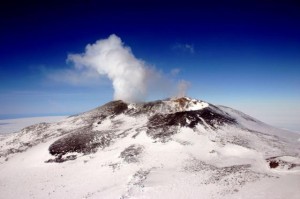Viewing videos of lava flows oozing or spewing out of the earth’s crust, listening to stories of people who have survived major earthquakes, interacting with maps showing volcanic activity – all of these are accessible due to the breadth of Internet resources and online tools available to us.
We’ve included here a brief overview of the online tools and the terms associated with the use of multimedia online. We also point out some resources you can integrate into your teaching or use to enhance your content knowledge.
TOOLS AND TERMINOLOGY RELATED TO MULTIMEDIA
Online Video
Since the introduction of broadband Internet with its high-speed access to large files, our ability to view video content online has dramatically increased. Video can be embedded into a web page and viewed without adding other computer software, or a multimedia player. Other video content may require that you download a player, such as QuickTime or Real Player, in order to view it.
Downloads for the players are free, with fee-based options for editing and additional features. The Windows Media Player often comes installed on computers using the Windows operating system.
The web site YouTube serves as a host site where users can create and share video, thereby broadening access to video materials on the Internet. (School firewalls commonly block access to YouTube. TeacherTube is a host site for educationally relevant videos and does not allow inappropriate content.)
iTunes
iTunes is a digital media player that you can download onto your computer. It allows you to play video and audio files and purchase music and other digital content. These files, or tracks, remain on your player so you can organize them for your use. An iPod is a small, portable device that allows you to transfer tracks from your iTunes application on your computer. You don’t have to have an Apple computer to view iTunes, but you do need to download the software to access it. Free downloads are available.
Podcast
Podcasts are portable files of audio and video content that can be accessed in a variety of ways. You can listen to or view them on a player such as an iPod. Podcasts can be distributed to subscribers through an automated system of distribution, known as an RSS feed. Like other media files, you can download a podcast to a digital media player individually as well. A video podcast, often called a vodcast, can be distributed in the same way.
Two videos produced by Common Craft explain podcast and RSS feed in simple terms. What is a Podcast? RSS feed?
MULTIMEDIA RESOURCES RELATED TO VOLCANOES AND EARTHQUAKES
Here are some online resources you might use for classroom activities:
Annenberg Media: Katmai Eruption
A video clip about the 1916 expedition to explore the aftermath of the 1912 volcanic eruption in the Katmai area of Alaska.
Regional Map of Alaskan Volcanoes from the Alaska Volcano Observatory
This interactive map indicates volcanic activity across Alaska.
Mount Erebus Volcano Observatory, Antarctica
The MEVO (Mount Erebus Volcano Observatory) playlist includes videos of eruptions from the world’s southernmost active volcano.

The summit of Mt. Erebus from the front seat of a helicopter. Photo courtesy of Mt. Erebus Volcano Observatory.
Hawaiian Volcano Observatory: Kilauea Volcano Time Lapse Movies
These time-lapse movies of lava flows were taken at the observatory by the U.S. Geological Survey (USGS). Check out the East Lae’apuki Lava Delta Collapse in which a bench of lava material at the edge of the ocean breaks and falls off over time.
Dragonfly TV: Lava Flows
Dragonfly TV is a public broadcasting show on both television and online. Each episode is hosted by teenagers, with special attention to encouraging girls and minorities to pursue interests in science. The lava flow video gives an overview of how volcanoes are formed in the Hawaiian Islands.
iTunes: Hawai’i Volcanoes National Park
Go to the iTunes store and do a search on the word “volcano.” You will find this short vodcast from the National Park Service that gives an overview of the formation of the Hawaiian Islands and the types of lava flows you can find there. The video is captioned so it can be used for reading comprehension activities.
Earthquakes
An Alaskan Welcome (Earthquake) from One Great Moment
Jim and Pinky Richardson recount their experience in the Alaskan Earthquake of 1964 in this podcast from the One Great Moment series.
Dragonfly TV: Earthquakes
Carol Reiss, marine geologist, talks about her experiences as a geologist and her research on earthquakes.
Earthquake in the Midwest
The U.S. Geological Survey produced this and the podcast below about earthquakes.
CBS News: Hunting A Quake’s Clues
This article focuses on an earthquake that occurred in the Fairbanks area five years ago and what it can tell us about earthquakes in other regions. Accompanying this article, in the related material section, is an interactive feature titled “Ground Shakers.” It has a series of interactives that demonstrate concepts associated with the study of earthquakes.
This article was written by Robert Payo. For more information, see the Contributors page. Email Kimberly Lightle, Principal Investigator, with any questions about the content of this site.
Copyright December 2008 – The Ohio State University. This material is based upon work supported by the National Science Foundation under Grant No. 0733024. Any opinions, findings, and conclusions or recommendations expressed in this material are those of the author(s) and do not necessarily reflect the views of the National Science Foundation. This work is licensed under an Attribution-ShareAlike 3.0 Unported Creative Commons license.

